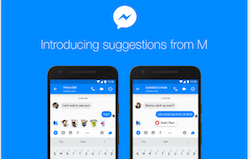 Facebook recently announced the general availability of M for Facebook Messenger users in the U.S. Two aspects about the announcement are worth noting. The first is that Facebook has chosen to release a purely automated form of the M assistant. During the beta period, M was a hybrid solution in which the automated assistant relied heavily on humans to both comprehend and fulfill user requests. The newly announced general release U.S. version no longer leverages human smarts.
Facebook recently announced the general availability of M for Facebook Messenger users in the U.S. Two aspects about the announcement are worth noting. The first is that Facebook has chosen to release a purely automated form of the M assistant. During the beta period, M was a hybrid solution in which the automated assistant relied heavily on humans to both comprehend and fulfill user requests. The newly announced general release U.S. version no longer leverages human smarts.
A second interesting aspect of the newly released M is the scope of the offering. Demonstrations of the human-assisted M often included complex use cases, such as a user needing a suggestion for a last-minute gift. M could not only recommend a great gift idea, but the assistant could seamlessly execute both purchase and shipping on the user’s behalf.
The M that’s now available for all Facebook Messenger users in the U.S. appears to be a dramatically scaled down version of the human-assisted one. In the announcement, Facebook cites the following six capabilities of the assistant:
- Suggesting stickies
- Facilitating payments
- Sharing location
- Coordinating plans among friends
- Starting a poll
- Hailing a rideshare service
All of these tasks lend themselves to fairly straightforward process automation. The steps required to hail a rideshare service follow a pattern with little variability. The same holds true for the other automated services offered by the new M.
Just last week we posted an article discussing contrasting views on what some are claiming to be the demise of chatbots in 2017. Ted Livingston, CEO of Kik, postulates that chatbots need tight integration to payment solutions in order to survive. Rurik Bradbury of Liveperson, on the other hand, sees the need for chatbots to better integrate with skilled human agents.
Facebook seems to be going down the path cited by Livingston. Their approach appears to be to keep interactions with the M assistant simple, predictable, and completely automated. At the same time, they are leveraging M to make user’s aware of services they wish to promote–the primary of these being Facebook’s payments solution. As we noted in last week’s article, Tencent’s WeChat is earning significant revenue from the use of its payment system, which is especially favored for peer-to-peer payments.
While Facebook originally painted more ambitious goals for M, pragmatism seems to have won the day. For now, M will stick to carrying out a finite number of easily scripted tasks, while nudging users to take advantage of key Messenger services.
The evolution of Facebook’s M seems to align with the evolution of conversational interfaces on messaging platforms in general. Early hype has given way to more focused, practical solutions. That doesn’t mean the day won’t come when an automated chatbot can find the best gift for your spouse, buy it with your credit card info, and have it delivered. It just means that companies are learning to avoid user frustration by sticking to interactions that work well as the technology matures.
This strategy seems like a good one for all concerned. It remains to be seen how humans will be successfully integrated into the process. Join us at our upcoming Intelligent Assistants Conference London (4-5 May) to discuss this topic and many others related to striking the balance between humans and intelligent assistant technologies.
Categories: Conversational Intelligence, Intelligent Assistants, Articles

 2025 Conversational AI Intelliview: Decision-Makers Guide to Self-Service & Enterprise Intelligent Assistants
2025 Conversational AI Intelliview: Decision-Makers Guide to Self-Service & Enterprise Intelligent Assistants  Talk to the Web: How NLWeb Opens Conversational Access to Site Content
Talk to the Web: How NLWeb Opens Conversational Access to Site Content  Voice AI Agents Redefine CX: Trends, ROI, and Strategies for 2025
Voice AI Agents Redefine CX: Trends, ROI, and Strategies for 2025  Why Voice AI Is Foundational for Enterprise Innovation (Webinar)
Why Voice AI Is Foundational for Enterprise Innovation (Webinar)